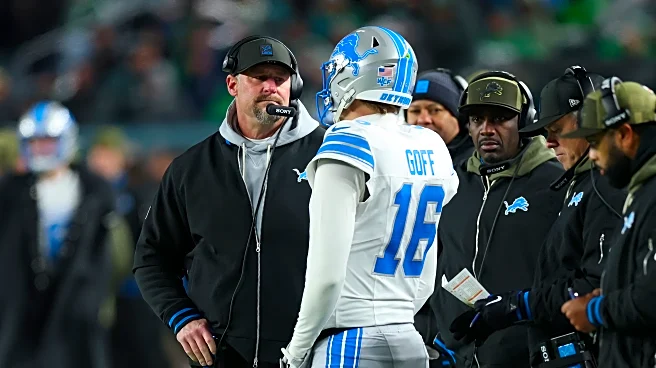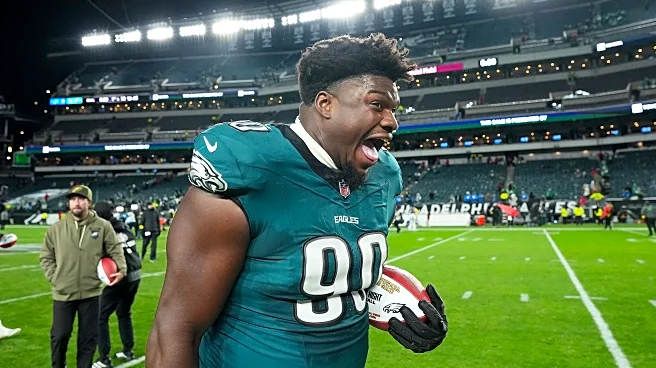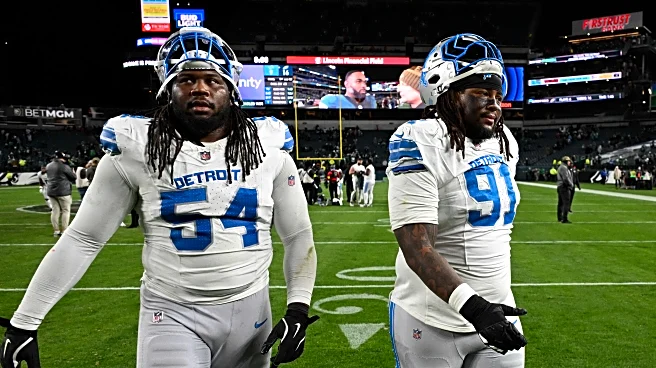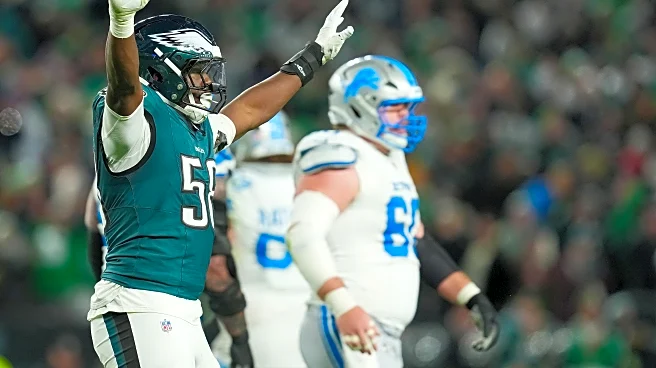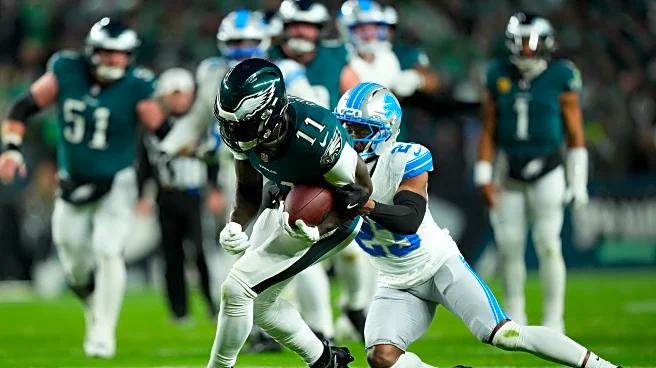It’s a recap article I’ve written far too many times already before Thanksgiving this season. A flat-footed Lions offense got punched in the mouth and never found its footing. The Eagles defense smothered
Jared Goff, choked off the passing game, and closed every running lane as the offensive line was overwhelmed and receivers were blanketed. It was the same painful script the Lions saw against the Packers and Vikings, not something they dealt with last season.
The Eagles’ front, much like those Packers’ and Vikings’ units, nearly won the game by itself by putting Detroit’s offense in a straitjacket.
On the road, against a team that is 24-3 in their last 27 games, Dan Campbell didn’t have the offense ready for the environment; they failed to adjust, and he made a few questionable decisions while juggling head-coaching and play-calling duties. The “gotta have it” moments weren’t there either. At this point, the idea of “just one of those games” is losing meaning—the problems are popping up too often, and the root cause looks familiar.
Last year, Detroit had several impressive comebacks—including against two tough defenses in Houston and Minnesota—but this season they haven’t looked composed or adaptable when chasing points. Once the offense appears to be dead on arrival a few drives in, it’s been a Shane “Footsteps” Falco quicksand effect. This group has proven they can’t overcome early offensive deficiencies or play one-dimensionally.
The Lions defense kept them in this game, their third loss in five games, but the offense was never able to capitalize, even with Vic Fangio and the Eagles defense preparing on a slightly short week, and for that they’re tagged with a bevy of stock down reports.
Stock down: Amon-Ra St. Brown, WR
The Lions opened with a play-action rollout to St. Brown, and he later ripped off a 34-yard catch—tied for his longest of the season—on a well-timed insert-motion play-action shot. Outside of those two grabs and a handful of quality blocks (including a key one on Jahmyr Gibbs’ 42-yard screen), it was an unusually unimpressive and inefficient outing for Detroit’s most reliable receiver.
St. Brown tied for the eighth-most targets of his career (12), yet came away with just two catches. He has 30 career games with at least 10 targets, and he’s recorded six or more receptions in 29 of them. Against Philadelphia, he was targeted on seven of Detroit’s 18 third- or fourth-down attempts—all incompletions—and saw seven targets in the second half alone without a single grab. For an offense gasping for any spark, he wasn’t able to pull them out of the spiral.
Not every miss was his responsibility—several were off-target throws from Goff, and the pass protection collapsed repeatedly. But a few were makeable, especially on money downs, where Detroit desperately needed him to win. The Lions gave St. Brown frequent free releases using “cheat” (outward) and “short” (inward) motions, yet he struggled against Quinyon Mitchell, Cooper DeJean, and, most disappointingly, the much-maligned Adoree’ Jackson. In the second half especially, routes were less crisp, and were jammed up by contact at the top of the route.
St. Brown’s 16.6% catch rate was the lowest of his career—and the lowest single-game mark for any player in the NFL this season. A night he’ll want to put in the rearview as the sun sets on a forgettable performance.
Stock up: Rock Ya-Sin, CB
Complete malarkey defensive pass interference calls aside, Ya-Sin answered the call and played one of his best games of the season while tracking A.J. Brown for most of the evening.
After giving up a first down to Brown on the first third down of the game—10 seconds in—Ya-Sin locked in. Like biscuits on gravy, Rock Ya-Sin smothered Brown the rest of the way. He provided tight coverage on an incomplete goal-line slant on third down, stopped Brown short of the sticks on two different third down in-breakers, and carried him stride for stride on two deep incompletions along the sideline (including a third-and-long shot). In total, he was targeted eight times on Brown and allowed only four completions for 37 yards, with just two first downs surrendered, and five of the targets coming on tight windows (per NextGen Stats).
He also added two strong open-field tackles on Saquon Barkley and, overall, continued to validate why Detroit’s front office viewed him as such a savvy signing. He’s putting together one of the best seasons of his career, allowing a career-low 79.9 passer rating in coverage.
Stock down: Tate Ratledge, RG
Ratledge had been stacking together some solid games—adapting quickly as a run blocker starting with the Ravens matchup and looking more composed in pass protection after some rough snaps against the Chiefs. But young-player development isn’t linear, and Week 11 was a full-on baptism by fire that included brief injury exits (88.1% of snaps).
His head was spinning trying to handle the Eagles’ talent up front. Jalen Carter was a frequent opponent, and while Ratledge had a few strong anchor reps, he was also beaten by bull rushes (including one that drew a holding call as he was walked back), a spin, and a club move. He surrendered pressure to Jaelan Phillips when he was late picking him up in slide protection off a blitz, and his roughest snap came when Moro Ojomo rocked him with a club that sent him flying like a drunken sailor who’d lost his equilibrium. Carter also left him reaching and on the ground more in run blocking than Ratledge had shown in recent weeks.
It was a harsh lesson in his 10th start, but also the kind of game that gives a young guard plenty to correct and build on moving forward.
Stock down: Kayode Awosika, LG
Awosika looked outstanding—given the circumstances—against the Commanders in Week 10, but he took a step back against the Eagles in what was just his ninth career start.
Much like Ratledge, Awosika was charged with three pressures allowed and a pass batted at the line. Punishing jumpers—defensive linemen timing the throw and exposing their rib cage—is a technique refresher both guards (and even Graham Glasgow) could use from Professor Hank Fraley. In pass protection, Awosika struggled with Jordan Davis’ power and length, giving up two quick pressures on swipe/rip moves, including one on the goal line, and allowing Davis to notch one of his three batted passes. He also failed to properly pick up an inside stunt by Jalyx Hunt working across Taylor Decker’s face.
The interior’s inability to generate displacement was also a major factor in Detroit’s pedestrian ground game. The Lions managed just 3.5 yards per rush overall—and only 2.9 yards per carry between the B-gaps—an area where gap-scheme runs usually give them better footing.
It was one of those games where the offensive line was overwhelmed in both phases and the issues compounded. Awosika and Ratledge were thrown into the deep end against one of the best interior fronts in football. They’ve now seen that speed and power firsthand, and Detroit will need them to settle in down the stretch.
Stock up: Jack Campbell, LB
Campbell operates as a human anvil in the run game, and he stepped up against the Eagles’ offensive front to blunt their ground attack as much as anyone on the field.
He paced the Lions with a career-high 15 tackles (7 solo) and played exactly the kind of physical, downhill football Detroit needed. Campbell flowed to the ball with urgency, shot gaps, shed blocks, and consistently made life difficult for Saquon Barkley. He contributed to 11 total tackles on Barkley alone, with six coming behind, at, or within three yards of the line of scrimmage—including a critical second-and-medium tackle for loss that helped force a three-and-out.
Campbell was a central piece in holding Barkley to 3.1 yards per carry on 26 attempts, in the Lions’ terrific Tush Push resistance, and in chasing down Jalen Hurts on scramble attempts. He was one of the few bright spots in an otherwise bruising afternoon.
Stock down: Aidan Hutchinson, DE
As a pass rusher, Hutchinson still found ways to affect the game. He recorded five pressures, split a sack with Roy Lopez on his quick interior win, drew a holding penalty on Lane Johnson, and beat backup right tackle Fred Johnson twice—once with a sharp inside spin with the Eagles backed up against their own end zone and once with a bull rush that collapsed the pocket with both flushing Hurts to scoot out.
But Hutchinson is in this section because of his run defense, the area Kelvin Sheppard and this defense emphasize above all else. Against Philadelphia’s battering-ram approach, he didn’t hold up. On the Eagles’ only touchdown drive, they went directly at Hutchinson over and over—and kept moving the sticks.
The sequence started with a 5-yard pistol counter. On the next snap, a favorable second-and-13, Hutchinson abandoned outside contain while trying to slip under a pulling guard, resulting in a 17-yard gain. That was followed by a read-option where he was washed inside by a tight end, giving Tank Bigsby a clean edge. And on Barkley’s 5-yard almost touchdown run, Hutchinson was trapped by an H-back after turning parallel to the line of scrimmage rather than meeting the block square. In total, the Eagles gained 34 yards on four carries (8.5 YPC) directly at him on that drive—ultimately scoring what became the game-winning touchdown before halftime.
In moments like this, a defender paid among the NFL’s elite can’t become the focal point of an opponent’s run script. The standard for Hutchinson is rightfully high, and on Sunday, he didn’t meet it. On the road, under a big spotlight, his presence needs to be felt with more game-changing plays.
Quick hits
STOCK UP
- Jahmyr Gibbs, RB: His first career 100-yard receiving game, highlighted by four catches for 103 yards in the third quarter alone (the fifth-highest total in any third quarter over the last four seasons). The Lions must continue to make him a focal point in the passing game.
- David Montgomery, RB: Despite a game script that didn’t favor him, he maximized his limited opportunities, averaging over 5 yards per touch on seven touches. He provided the expected tough running against a stout Eagles defensive front.
- Trystan Colon, RG: A valuable, versatile interior offensive line addition. A week after playing 9 snaps at left guard and 10 at center, he again filled in for injury, playing seven snaps at right guard for Ratledge.
- Tyleik Williams, DT: Williams earned his most snaps (36) since Week 4 and had his most active game as a run defender of his young career, occasionally crushing the can as a pass rusher.
- D.J. Reader, NT: A valuable bounce-back game. Reader was stout at the point of attack and a vital component in successfully thwarting short-yardage and Tush Push efforts. He was particularly impressive as a bully at the line of scrimmage in the fourth quarter as the Lions desperately tried to get the ball back.
- Roy Lopez, DT: Lopez continues to provide valuable snaps, flashing again with a half-sack by swimming past center Cam Jurgens and through right guard Tyler Steen, and effectively working Jurgens in the run game.
- Amik Robertson, CB: Matched up well with DeVonta Smith, holding him to zero catches on three targets. He also sniffed out a screen to A.J. Brown for a tackle for loss, proving he is one of Brad Holmes’ best free agent signings.
- Brian Branch, SAF: Similar to Campbell, Branch was a perfect fit to disrupt the Eagles’ attack. He was a Tasmanian Devil all over the field, bringing down Barkley and Bigsby numerous times as a second- or third-level enforcer in the run game, and was a plus player in coverage on both Dallas Goedert and Kylen Granson (delivering a hard hit on the latter).
- Thomas Harper, SAF: Harper was active coming downhill in run support of Barkley, taking excellent angles. He had an outstanding play on a play-action boot, blasting A.J. Brown for minimal gain near the goal line. He filled in admirably for Kerby Joseph, helping to limit strikes over the middle of the field.
STOCK DOWN
- Graham Glasgow, C: Had his hands full with Jordan Davis and the Eagles’ blitzing linebackers.
- Penei Sewell, RT: His least effective game as a ground and pound punisher this season. He had two costly, poor protection reps: missing his stab and lunging twice. He allowed Jaelan Phillips into Goff’s grill on a critical fourth-down goal-line play and surprisingly lost an inside counter-move rep to the 37-year-old previously retired Brandon Graham, which caused a rushed, inaccurate incompletion.
- Brock Wright, TE & Isaac TeSlaa: They need to step up considerably more than their combined eight targets, two catches, and eight receiving yards on 42 pass routes to fill the void left by Sam LaPorta’s absence.
- Jared Goff, QB: A career-low completion percentage (37.8%). He was only 3/17 (17.6%) passing past the line of scrimmage on non-play-action throws and a dreadful 1/13 (7.7%) when pressured. With five passes batted at the line of scrimmage, it simply wasn’t Goff’s night.
- Al-Quadin Muhammad, DE: His early-season effectiveness is diminishing; he was hardly a factor as a pass rusher.
- Tyler Lacy, DE: He was exposed as not being an ideal athletic edge fit on a handful of outside runs, particularly on read options, and on play-action rollouts. He also failed to provide any meaningful pass rush bull rushes he is capable of.
- Derrick Barnes, LB: He was juked out by Saquon Barkley on one decent run, sucked in on containment by ball fakes on other runs, and was left grasping for air in coverage of Dallas Goedert on a quick play-action waggle.
STOCK NEUTRAL
- Jameson Williams, WR: He was an avenue for Goff under pressure (19-yard first-quarter catch), utilized his blazing speed on an impressive 40-yard touchdown, and provided a late spark with a big fourth-quarter grab. However, his unsportsmanlike conduct penalty cost the Lions a point, negatively affecting in-game scenarios and decisions from there on out. Furthermore, he must find a way to secure that fourth-down drop on the slant. He’s in Year 4 and earned a big extension, these negative aspects need to be consistently eliminated from his game.
- Alim McNeill, DT: High-level flashes were evident at times in both run defense and as a pass rusher, but he needs far more consistency. Additionally, while the staff is trying to get creative to get players on the field, McNeill rushing off the edge is not an effective use of his talent.



